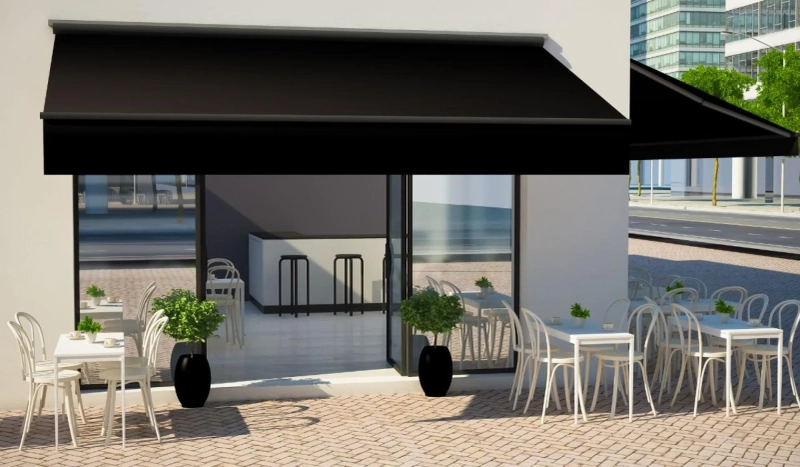Outdoor living spaces have become an essential extension of the home—places where we relax, entertain, and enjoy the fresh air. Whether it’s a cozy patio, a poolside deck, or a spacious veranda, adding the right shade solution can greatly enhance both the comfort and style of your outdoor area. Among the most popular and versatile choices are fabric outdoor awnings.
But with so many options available, how do you choose the right one? From material types to design features, this guide will walk you through the key factors to consider when selecting the perfect fabric awning for your outdoor space.
1. Understand the Benefits of Fabric awnings
Fabric awnings are favored for their versatility, aesthetic appeal, and functional benefits. Here’s why they’re a top pick for homeowners:
- Sun and UV Protection: A good fabric awning offers excellent shade and helps block harmful UV rays, protecting people, furniture, and flooring.
- Rain Shelter: Water-resistant fabrics can provide cover during light rain, allowing outdoor spaces to be used more frequently.
- Temperature Control: By shading windows and doors, awnings help reduce indoor heat, potentially lowering air conditioning costs.
- Aesthetic Value: Available in a wide variety of colors, patterns, and styles, fabric awnings can complement almost any exterior design.
- Retractable Options: Many fabric awnings can be retracted when not in use, preserving their lifespan and offering flexible coverage.
2. Choose the Right Fabric Material
The durability and performance of your awning depend largely on the type of fabric used. The most common fabric types include:
a. Acrylic Fabric
Acrylic is ideal for outdoor use because it’s breathable, resistant to mildew, and retains color well over time. Solution-dyed acrylics, such as Sunbrella® fabrics, are especially durable and popular for residential and commercial awnings.
Pros:
- UV and fade-resistant
- Water-resistant
- Wide range of color options
Cons:
- More expensive than polyester or cotton blends
b. Polyester Fabric
Polyester is a more budget-friendly alternative. When coated with acrylic or PVC, it becomes more weather-resistant.
Pros:
- Cost-effective
- Good print quality for custom designs
- Lightweight and easy to handle
Cons:
- May fade faster than acrylic over time
- Less breathable
c. Vinyl-Coated Fabrics
These are generally polyester fabrics coated with a layer of vinyl for added durability. They’re highly water-resistant and often used for commercial-grade awnings.
Pros:
- Excellent for rainy climates
- Easy to clean
- Mold- and mildew-resistant
Cons:
- Less breathable
- Can get hot under direct sun
3. Consider Awning Style and Functionality
Your awning’s style should align with your functional needs and architectural design. Here are a few popular types:
a. Retractable Awnings
Perfect for patios and decks, these can be manually or motor-operated. They offer flexibility—extend them when you want shade and retract when you prefer full sunlight or during storms.
b. Stationary (Fixed) Awnings
These are permanent structures, ideal for windows, doors, or entryways. They provide continuous protection and tend to be more durable.
c. Freestanding Awnings
Great for larger spaces like pool areas or gardens where wall mounting isn’t an option. They can often shade multiple areas simultaneously.
d. Drop Arm Awnings
Ideal for windows and balconies, these pivot outward and downward to provide adjustable shade and privacy.
4. Think About Color and Design

The color and pattern of your awning fabric are more than just aesthetic choices—they can impact temperature and mood.
- Light Colors reflect more sunlight and help keep areas cooler, making them ideal for hot climates.
- Dark Colors absorb more heat but provide a cozy and elegant ambiance.
- Stripes and Patterns can add personality and are especially popular in coastal or traditional home designs.
When selecting a color, also consider how it will coordinate with your home's exterior—roof, siding, and trim—as well as patio furniture.
5. Evaluate Durability and Maintenance
Outdoor awnings are constantly exposed to the elements, so durability is key. When comparing fabrics:
- Look for UV-resistant materials to prevent fading.
- Check the warranty—longer warranties often indicate higher quality.
- Consider ease of cleaning—some fabrics are mildew-resistant and only require occasional rinsing with water and mild soap.
Pro tip: Retracting or covering your awning when not in use can significantly extend its lifespan.
6. Assess Installation and Budget
While some homeowners opt for DIY kits, many awnings—especially motorized or custom-designed ones—require professional installation. When budgeting:
- Factor in installation costs
- Include optional features like wind sensors, remote controls, or LED lighting
- Balance initial cost with long-term value—higher-quality fabrics and frames may cost more upfront but last longer
A professionally installed fabric awning can last 10–15 years or more with proper care, making it a worthwhile investment in your outdoor comfort.
7. Check Local Regulations and HOA Guidelines
Before installation, check for any local building codes or homeowners’ association (HOA) guidelines that might restrict awning styles, colors, or dimensions. Some areas may require permits for large or permanent structures.
Conclusion
Choosing the right fabric awning for your outdoor space involves balancing form and function. You’ll need to consider materials, colors, styles, and weather-resistance features that best suit your environment and lifestyle. Whether you want to host backyard parties, create a quiet reading nook, or simply protect your home from the sun, the right awning can elevate your outdoor experience while adding beauty and value to your home.
Take the time to explore your options, and don’t hesitate to consult a professional for guidance. With the right choice, you’ll enjoy shaded comfort and stylish outdoor living for years to come.


